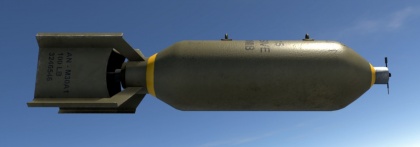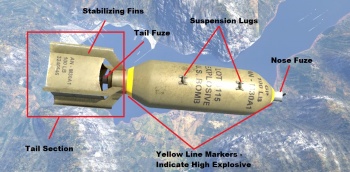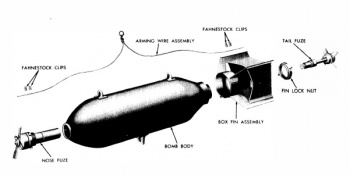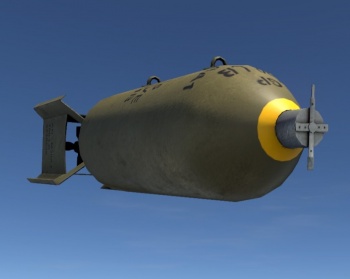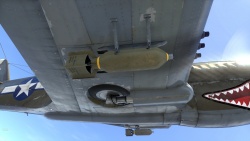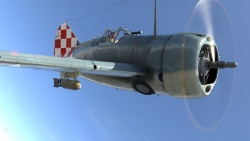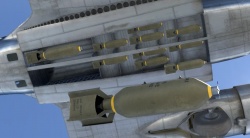Difference between revisions of "AN-M30A1 (100 lb)"
m (Added caption to image.) |
m (Edits.) |
||
| Line 1: | Line 1: | ||
== Description == | == Description == | ||
<!--''Write an introduction to the article in 2-3 small paragraphs. Briefly tell us about the history of the development and combat using the weaponry and also about its features. Compile a list of air, ground, or naval vehicles that feature this weapon system in the game.''--> | <!--''Write an introduction to the article in 2-3 small paragraphs. Briefly tell us about the history of the development and combat using the weaponry and also about its features. Compile a list of air, ground, or naval vehicles that feature this weapon system in the game.''--> | ||
| − | [[File:AN-M30A1_Sideview.jpg|420px|thumb|left|Side view of an '''{{PAGENAME}}'''.]] | + | [[File:AN-M30A1_Sideview.jpg|420px|thumb|left|Side view of an '''{{PAGENAME}}''' bomb.]] |
{{break}} | {{break}} | ||
Revision as of 00:10, 5 April 2019
Contents
Description
The AN-M30A1 (100 lb) is an American general purpose high explosive (HE) bomb.
The AN-M30A1 is an air-dropped bomb which utilises a combination of blast damage, penetration and fragmentation during its explosive effect. Typically the general purpose bombs are used when targeting either enemy troops, vehicles and buildings.
The AN-M30A1 utilises two types of fuzes to detonate the bomb with the nose fuze which is the main fuze and the one in the tail as a backup. General purpose bombs are aerodynamic in shape and have stabilising fins to enable accurate drop locations when sighted, targeted and released by a bombardier. The aerodynamic effect also benefits aircraft which carry the bombs on external payload pylons.
| Data for AN-M30A1 (100 lb) bomb | |||
|---|---|---|---|
| In-game | Historical[1] | ||
| Overall Length | -- | 102.26 cm | 40.26 in |
| Body Diameter | -- | 20.8 cm | 8.18 in |
| Fuse Type | -- | Nose | Tail |
| Filling | Amatol | Amatol | Amatol |
| Filling Weight | 24.5 kg | 24.5 kg | 54.01 lb |
| Total Weight | 45.35 kg | 52.84 kg | 116.5 lb |
Vehicles equipped with this weapon
| Vehicles equipped with this weapon | |
|---|---|
| Fighters | |
| F2A | F2A-3 |
| F3F | F3F-2 · Galer's F3F-2 |
| F4F | F4F-3 · F4F-4 |
| F4U | F4U-4 |
| P-26 | P-26A-33 · P-26A-34 · P-26A-34 M2 · P-26B-35 |
| P-40 | P-40E-1 · P-40F-10 |
| P-51 | A-36 · P-51 · P-51A · ▄Mustang Mk IA · P-51D-10 · P-51D-5 · P-51H-5-NA |
| Jet fighters | |
| F-84 | F-84B-26 · F-84G-21-RE · ▄F-84G-26-RE · ▄F-84G-21-RE |
| F9F | F9F-2 · F9F-5 |
| Attackers | |
| A-26 | A-26B-50 · A-26B-10 |
| OS2U | OS2U-1 · OS2U-3 |
| PBJ-1 | PBJ-1H · PBJ-1J |
| XA-38 | XA-38 |
| Bombers | |
| A-26 | A-26C-45 · A-26C-45DT |
| B-18 | B-18A |
| B-24 | B-24D-25-CO · PB4Y-2 · ▄PB4Y-2 |
| B-25 | B-25J-1 · B-25J-20 |
| Hudson | ▄Hudson Mk V |
| PBM-3 | PBM-3 "Mariner" |
| PBY-5 | PBY-5 Catalina · PBY-5A Catalina · ▄Catalina Mk IIIa · ▂PBY-5A Catalina |
| SB2U | SB2U-2 · SB2U-3 |
| SBD-3 | SBD-3 |
| TBD-1 | TBD-1 |
| V-156 | V-156-B1 |
General info
This bomb was manufactured in one of three ways, either cast or spun as one piece, cast as two pieces and welded or cast as three pieces and welded. The nose contained a threaded opening which is closed by the fuze-seat liner and the male plug at the tail is closed by an explosive adapter booster.
The AN-M30A1 is outfitted with two suspension lugs which are directly welded to the bomb casing 14 inches apart. A single suspension lug is welded to the opposite side of the bomb at the centre of gravity which can be utilised to suspend from British aircraft.
This version of the AN-M30 bomb, the A1 version indicates that a modification which locks the base plate to the central filling via two steel pins, preventing the removal of the base plate once the bomb is filled with its explosive material. Once the adapter booster is inserted, a pin is inserted which prevents its withdrawal.
The tail section of the AN-M30A1 bomb is a cast-steel sleeve known as a box-type tail. The Sleeve is manufactured of a cast-steel sleeve with four sheet-steel fins held into place with a locking nut. Each fin is held by a fin-strut which once in place are welded together to make one assembly. Different tail fins were utilised when the low-altitude bombing took place compared to higher altitude bombing.
The impact nose fuze is vane operated and delayed armed meaning that when the bomb is dropped, the vane spins, arming the bomb away from the plane dropping it. After arming, the bomb will detonate when the impact fuze comes in contact with an object. Detonation can be set to be instantaneous when the bomb hits something or with a delay, allowing the bomb to burrow into the ground before detonating. The impact tail fuze is also vane armed and can be set to delayed detonation. Tale fuzes are typically used with nose fuzes as a backup detonator in case the primary fails.
The AN-M30A1 was painted with a standard colour scheme since 11 March 1942; the body was painted olive drab while yellow stripes were added to indicate the bomb was a HE. To differentiate what type of filler was used, a one-inch yellow band at the nose and tail along with a 1/4 inch dotted band at the centre of gravity of the bomb which indicated it was filled with 50/50 Amatol or TNT fillers. A second yellow band was added to the nose and tail of the bomb if it was filled with Composition"B" which required special handling due to its sensitivity. Standard marking on the bomb body in black paint included type, weight, the name of the bomb, type of filling, lot number, date and place of filling along with the inspector's initials. Indestructible markings of this information were also stamped into the casing before filling with explosives.
Effective damage
| AN-M30A1 (100 lb) damage table | Metric | Imperial |
|---|---|---|
| Max armor penetration high explosive action | 79 mm | 3.11 in |
| Radius of destruction of armored vehicle | 2.1 m | 6.9 ft |
| Radius of fragment dispersion | 67.3 m | 220.8 ft |
Comparison with analogues
| Comparable bombs to AN-M30A1 (100 lb) | |||||||
|---|---|---|---|---|---|---|---|
| Name | Mass | Explosive mass | Explosive | Armor Pen. | Destruction radius | Frag radius | |
| ▂ | FAB-50 | 64 kg | 24 kg | TNT | 79 mm | 2.1 m | 68.6 m |
| ▀ | SC50JA | 50 kg | 25 kg | Fp.60/40 | 80 mm | 2.1 m | 70.1 m |
| ▅ | Type 97 Number 6 | 60 kg | 23 kg | TNT | 78 mm | 2.1 m | 67 m |
| ▅ | Type 94 GPHE | 50 kg | 19.6 kg | TNT | 74 mm | 1.8 m | 62.5 m |
| ▄ | GP 50 | 58 kg | 25 kg | TNT | 80 mm | 2.1 m | 70.1 m |
| ▄ | G.A.M.Mn 50 | 50 kg | 28.5 kg | TNT | 82 mm | 2.4 m | 77.1 m |
| ▄ | D.T. No.2 | 55.7 kg | 19.9 kg | TNT | 73 mm | 2.1 m | 67.4 m |
Usage in battles
The AN-M30A1 (100 lb) is a general purpose HE bomb which was utilised by fighters, attackers and bombers. Due to its size, either one or two could be outfitted to a fighter or attacker allowing it to perform low-level precision bombing on AAA or light vehicles. Bombers can carry between 12 to 16 of these bombs and could drop them all in one location bombing a base or could spread them out across the map depending on where the targets of opportunity are.
Pros and cons
Pros:
- Effective usage on light vehicles and soft targets
- Allows fighters to equip and perform low-level bombing runs
- In quantity can be effective against columns of vehicles from low-level bombing
Cons:
- Ineffective against hardened targets and large bases
- Usage against vehicles at higher altitudes provides time for vehicles to scatter
- If detonated within 2.1 m of a hardened vehicle only achieves up to 79 mm of penetration
History
The general purpose AN-M series bombs utilised in War Thunder are classified as "old-series" bombs which consist of a bomb body, fin assembly, fin locking nut, nose fuze, tail fuze, arming wires and safety clips. When possible, to safely ship bombs, the sensitive or fragile components were shipped separately and then assembled before use.
Media
-
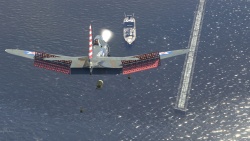 An SBD-3 dive bombing a ship with two AN-M30A1 (100 lb) bombs and one AN-M64A1 (500 lb)
An SBD-3 dive bombing a ship with two AN-M30A1 (100 lb) bombs and one AN-M64A1 (500 lb)
See also
Links to the articles on the War Thunder Wiki that you think will be useful for the reader, for example:
- reference to the article about the variant of the cannon/machine gun;
- references to approximate analogues by other nations and research trees.
External links
- Technical Order 11-1-28 - Bombs and Bomb Components
- OP 1664 - U.S. Explosive Ordnance
- OP 1280 - Aircraft Bombs


